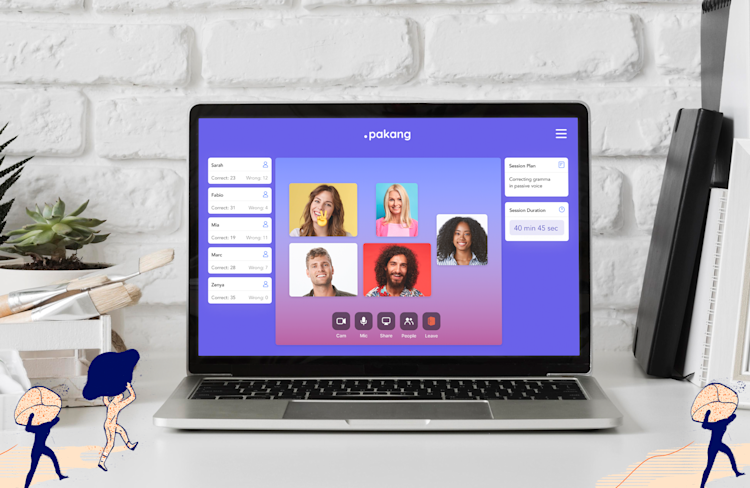WebRTC Video Chat: How WebRTC Experts Provide Quality, Security, and Cool New Features
WebRTC video chat is how video conferencing solutions offer super low delay speeds. This technology enables better quality, security, and advanced features.
How do video conferencing platforms offer low delays to make conversations natural? The answer is by building with WebRTC.
With real-time communication (as opposed to bulk-data transfer), we don’t have the luxury of requesting lost data, such as a video frame or a second of audio. When something is gone, it’s gone. That’s why protecting streaming and video quality is so important.
There are a lot of factors that affect WebRTC’s ability to provide real time streaming. And, there are so many amazing features that WebRTC enables, making it pretty much critical here at Whereby.
RTC stands for “real time communication,” and WebRTC literally means real time communication for the internet. This technology allows developers to add real-time communication to their applications, such as real-time video and/or audio conversations.

Here’s what WebRTC.org has to say:
With WebRTC, you can add real-time communication capabilities to your application that works on top of an open standard. It supports video, voice, and generic data to be sent between peers, allowing developers to build powerful voice- and video-communication solutions. The technology is available on all modern browsers as well as on native clients for all major platforms. - WebRTC.org
Of course, at Whereby, we build with WebRTC to create both audio and video conversations without delays. We’re proud to have true WebRTC experts in house, and we sat down with one of them to chat through it all.
WebRTC expertise is super rare
“Not very many engineers specialize in WebRTC. There are only a handful who really know RTC, as the whole technology is very young and very complex,” says Balázs Kreith, WebRTC engineer at Whereby. “Those who do specialize in it need to continually stay up to date. Browsers change frequently to better support WebRTC, and we need to keep pace with continued updates.”
But with our in house engineering expertise, we’re able to achieve these amazing results for our customers:
Better quality control and bug escalations
Because of the nature of the Whereby application (lightweight audio and video conferencing you’ll actually enjoy), we can’t control everything. We can’t control our customers’ network or environment. But we can troubleshoot to the fullest extent of our abilities to provide an accurate answer. And, whenever possible, we try to directly resolve the issue, instead of creating homework for our customers.
One of the best things that our engineers provide is accurate bug investigations and escalations.
“If we discover that an issue wasn’t due to our application, that means it’s the customers’ network. But we never just go back to them and say that,” explains Balázs. “We want to investigate further and figure out the exact cause as best we can, so we can help our customer get the best possible experience. For example, one customer noticed that the meeting quality suffered periodically. When we investigated the problem, we discovered that their cloud provider had made some security updates, so we contacted them to resolve it.”
Without this level of expertise, the customer experience with both the platform and support would suffer.
Security and privacy to meet the needs of regulated industries
“Some of our customers are in highly regulated industries, like healthcare and education. And throughout the pandemic, more of them have needed to offer sessions online,” says Balázs.
It’s very common for executives in these industries to vet WebRTC video chat solutions for WebRTC expertise. They want to know that their calls will be secure, and won’t be accessible to someone who’s not meant to listen in either live or via recordings. By working with a team that offers WebRTC expertise, the customer doesn’t need to build in security enhancements on their own – that’s all built into our product directly. Security features include:
Built for privacy from the ground up
GDPR compliant
Individual secure meeting rooms.
Building groundbreaking features faster (that don’t weigh down audio or video)
Our knowledge of WebRTC also makes it easier for our customers to get the features they need. Like any technology, WebRTC needs to be continuously coaxed to perform well alongside other features. At Whereby, we like conference calls to be simple and enjoyable.
Here are just a few of the features we have that play nicely with WebRTC:
No downloads required: Whereby works in any browser so no one has to download a mobile or desktop app. And we pay close attention to network and browser environments. Doing so keeps quality higher than downloadable video call solutions.
Scaling down video resolution: Our algorithm can scale video resolution down and up based on a user’s network bandwidth. If bandwidth is high, Whereby will show the highest possible video resolution. If it’s low, we’ll gradually scale it down if need be, so that the video can show without interrupting audio.
Emoji reactions and disappearing comments: Chat logs get long and complicated really quickly. This makes it hard to sort out questions and comments that need to be addressed in real time. To keep the engagement and interaction high and distractions low, we built emoji reactions and disappearing comments. These features add the fun but never impact video or audio quality.

It’s so important to build features that don’t slow down or negatively affect WebRTC. “With continuous streaming, we’re talking milliseconds, not minutes, like with email and other forms of online communication. We don’t have time to resend the data if something goes wrong. That’s why we prioritize audio and proactively scale down video in case of discrepancies to avoid severe quality degradation,” says Balázs.
Plus, we can build feature requests faster too. For example, we were able to spin up Breakout Groups in just a month, so our customers could offer smaller, more intimate experiences for people participating in large events. “Utilizing WebRTC, we were able to investigate how an increase in the number of videos would affect meeting quality,” says Balázs. “Today, the breakout groups initiate quickly, and offer the same level of video and audio quality that our core rooms do.”
WebRTC video chats are constantly evolving. And here at Whereby, we’re always making sure that real time actually means real time.


